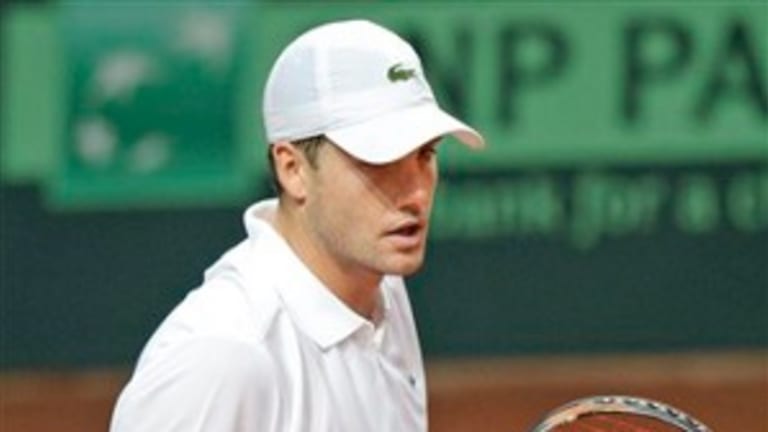Only a select handful of players stand a chance of beating Roger Federer, the all-time Grand Slam singles champion, with the sort of stylish, versatile tennis he has come to personify. John Isner is not one of those players, and to his good fortune he knows it. Thus, he was able to produce the best win of his career today in his Davis Cup clash with Federer in Fribourg, Switzerland—a victory that left the visiting Americans leading the favored Swiss two matches to none.
The unlikely turning point of the 4-6, 6-3, 7-6 (4), 6-2 match occurred after Federer won the first set easily, in 29 minutes. He appeared to be on cruise control, and Isner had trouble keeping the ball within the lines. Once again, it seemed, the tired narrative of how top players are always in mortal danger of being flummoxed by the atomic servers—the Isners and Ivo Karlovics of this world—seemed ready to be disproven.
Then, one of the underlying principles of that theory kicked in, and savagely. Despite knowing that the chances of breaking Isner, even on that slow, red clay, were slim, Federer played a truly abysmal service game while trailing in the second set but on serve at 2-3. That's the ultimate no-no. In the ensuing game, Federer fell behind 0-15 on a trio of sloppy errors, starting with a badly mistimed forehand (more about that later). He fought off those break points, and two more as well, but yielded the game on a brace of errors—a backhand miss following the kind of long rally Isner isn't supposed to win against Federer, or anyone else, and an inexplicable forehand error hit from the mid-court.
With that break in hand, Isner served out the second set, finding the groove with his inside-out forehand to Federer's backhand—Plan A, according to Isner's coach, Craig Boynton.
So far, though, the script was predictable: Heavy favorite takes his eye off the proverbial ball for a moment after building a solid lead, allowing opportunistic, go-for-broke big man to capitalize on said favorite's moment of weakness and steal a set. But I'm not sure anyone really expected what happened next.
Federer served first in the third set, and Isner menaced him right off the bat. The 6-foot-9 American was beginning to find the court with his own returns, and he seemed more confident and eager to seize opportunities to control the rallies. Federer had to fend off two break points and he managed to hold, but Isner had declared that he was in this one for the long run.
Significantly, and despite the reputations of these two men, Federer led Isner in the ace count for almost the entire match (Isner ended up with 14, just one more than Federer). But Isner served very well when it counted, particularly second serves. The sight of Federer having to retrieve backhand returns from way up above his shoulder was a common one.
The tiebreaker that decided the third set started with a point that was in some ways emblematic of the match. Serving, Federer got an atrocious bounce off an Isner return and thus shanked a forehand. Earlier in the week, Mardy Fish had observed that the clay court laid down in the Forum Fribourg was perhaps the worst-made court he had ever played a tour-level match on, especially when it came to the bounces. He presciently suggested that this might help the U.S. squad, given that it was more inclined to to play hit-and-miss tennis anyway.
Isner did a great job holding that mini-break advantage, but he blinked when serving for 5-3 in the tiebreaker. Federer leveled, but two points later drove a makeable forehand pass into the net to put Isner up 5-4—with two serves to come. He made the most of them, winning the set with an inside-out forehand that forced a Federer backhand error, and then a forehand drop volley winner.
The Federer faithful probably were still inclined to consider the Isner lead a temporary aberration, but everything from Isner's body language to the lousy bounces suggested otherwise. Federer, the maestro, was in trouble, and deeply so. Isner was taking very good care of his own serve and putting pressure on Federer by playing sharp, clean, first-strike, pre-emptive tennis.
And once again, we saw how a slow clay court can actually help a big server—or perhaps we should say, a big, slightly lumbering man?—by giving him that much more time to plant his feet and draw a bead on his shot.
By the middle of the fourth set, Federer seemed to be in retreat, as if backing off the baseline would enable him to lengthen the rallies. Instead it gave Isner even more time, and he took advantage both with his inside-out forehand and a point-ending backhand—a shot that he's sorely needed in his repertoire and which he used effectively on this day.
A break for 4-2 also broke Federer's spirit; it was the last game he would win.
—Pete Bodo
